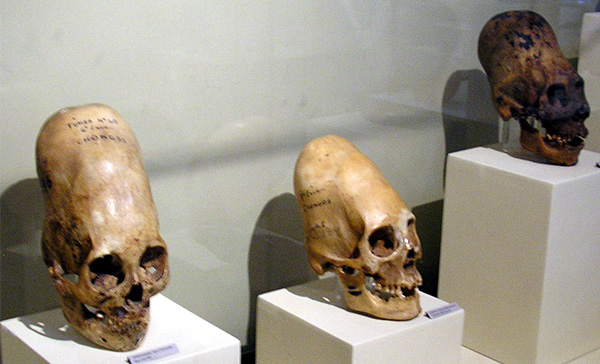THOSE STRANGE ELONGATED SKULLS… AND DNA…
Today I turn from financial and geopolitical high octane speculation, to a very different subject matter, one in a way a major source of interest for me: those strangely elongated hominid-like skulls found in Peru and elsewhere in the world. They have a major fascination for me, since the cover art for my book Genes, Giants, Monsters, and Men depicts one of those skulls in some of the most arresting book cover art I’ve ever seen. In fact, this is apparently a story that interests many of you since so many of you sent me various versions of this story(and thanks to all of you who did!):DNA Analysis of Paracas Skulls Shows they were not Human
As is known, some ancient tribes practiced binding human babies’ skulls between to boards, or in cloth, to produce these elongated skulls:
“It is usually achieved by binding the head between two pieces of wood, or binding in cloth. However, while cranial deformation changes the shape of the skull, it does not alter its volume, weight, or other features that are characteristic of a regular human skull.”But there is a problem in the case of the Paracas skulls:
“The Paracas skulls, however, are different.In other words, anatomically they do not appear to be human skulls, and given the cranial shape and volume, one may reasonably surmise that neurophysiologically they would have been different than humans as well.
Wikipedia Commons
“The cranial volume is up to 25 percent larger and 60 percent heavier than conventional human skulls, meaning they could not have been intentionally deformed through head binding/flattening.
“They also contain only one parietal plate, rather than two. The fact that the skulls’ features are not the result of cranial deformation means that the cause of the elongation is a mystery, and has been for decades.”
Now, however, this view has apparently been confirmed, and I cite the rather breathtaking conclusions of this article:
Mr. Juan Navarro, owner and director of the local museum, called the Paracas History Museum, which houses a collection of 35 of the Paracas skulls, allowed the taking of samples from 5 of the skulls.Now this is quite significant, for reading between the lines a bit, if the DNA findings are replicated, then we are indeed dealing with mDNA that lies outside all computer-reconstructed histories of mDNA from “mitochondrial Eve,” in short, with something else, and given that Foerster is indicating that it is a distant species from Homo Sapiens Sapiens, Neanderthal, and Denisovan man, then it is reasonable to conclude we are looking at something older, though as the article cautions, more analysis is needed. It could be these skulls are little-known contemporaries to these other human species. But if so, then another possibility opens up, a high octane possibility, one suggested from ancient texts: is there any evidence of the mingling of this unknown species with the three stated forms of humanity, homo sapiens sapiens, Neanderthal, and Denisovan man? If that were to be found to be the case, then affirmation of those ancient legends of gods coming down and interbreeding with humans would take another step toward being perceiving, not as mythology, but as the legacies of a little known or understood history.
“The samples consisted of hair, including roots, a tooth, skull bone and skin, and this process was carefully documented via photos and video. The samples were sent to the late Lloyd Pye, founder of the Starchild Project, who delivered the samples to a geneticist in Texas for DNA testing.
“The results are now back, and Brien Foerster, author of more than ten books and an authority on the ancient elongated headed people of South America, has just revealed the preliminary results of the analysis. He reports on the geneticist’s findings:
“‘It had mtDNA (mitochondrial DNA) with mutations unknown in any human, primate, or animal known so far. But a few fragments I was able to sequence from this sample indicate that if these mutations will hold we are dealing with a new human-like creature, very distant from Homo sapiens, Neanderthals and Denisovans.’
“The implications are huge. ‘I am not sure it will even fit into the known evolutionary tree,’ Foerster wrote. He added that if the Paracas individuals were so biologically different, they would not have been able to interbreed with humans.
“The results need to be replicated and more analysis undertaken before final conclusions can be drawn.” (Boldface emphasis in the original, italicized emphasis added)
On the other hand, if it were discovered that there was no such intermingling of species, then what do we have? Is this species ancient? Is it intelligent?(The cranial capacity, and the fact that they were discovered in graves, would suggest yes). If so, then are they from here? Foerster’s remaks seem to suggest that, with such an apparently different set of mutations and genetic history, that they are not. But if not, then did they evolve in total isolation from the rest of terrestrial mammals(are they mammals at all?), or are they from somewhere else?
Any way one slices the high octane speculation on this one, folks, this is a story to watch!

No comments:
Post a Comment